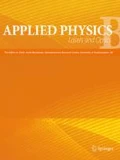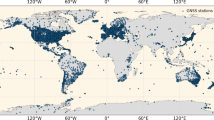Abstract
This paper applies a theoretical approach to the calculation of background noise levels during the analysis of lidar (light detection and ranging) data. We develop a method for the identification of background noise concealed within lidar signals under clear atmospheric or homogeneous aerosol layer conditions and derive an equation for the calculation of these noise levels from a theoretical consideration of the lidar equation. An increasing range-corrected signal indicates that a large amount of background noise exist in the return signal. We calculate the level of background noise by selecting three equidistant points in the return signal from the homogeneous layer and inputting the range and intensity of these points into the derived equation. Background noise calculations using actual lidar signals were in good agreement with calculations based on a simulated lidar signal. The background noise equation was verified using both observational lidar data and a simulated signal, indicating that it provides a reasonable measure of background noise levels in lidar data.







Similar content being viewed by others
References
T. Fujii, T. Fukuchi, N. Cao, K. Nemoto, N. Takeuchi, Trace atmospheric SO2 measurement by multiwavelength curve-fitting and wavelength-optimized dual differential absorption lidar. Appl. Opt. 43, 524–531 (2002)
N. Cao, S. Li, T. Fukuchi, T. Fujii, R.L. Collins, Z. Wang, Z. Chen, Measurement of tropospheric O3, SO2 and aerosol from a volcanic emission event using new multi-wavelength differential-absorption lidar techniques. Appl. Phys. B 85, 163–167 (2006)
N. Cao, T. Fuchichi, T. Fujii, R.L. Collins, S. Li, Z. Wang, Z. Chen, Error analysis for NO2 DIAL measurement in the troposphere. Appl. Phys. B 82, 141 (2006)
T. Fukuchi, T. Nayuki, N. Cao, T. Fujii, K. Nemoto, Differential absorption lidar system for simultaneous measurement of O3 and NO2: system development and measurement error estimation. Opt. Eng. 42(1), 98–104 (2003)
Z. Wang, J. Zhou, H. Hu, Z. Gong, Evaluation of dual differential absorption lidar based on Raman-shifted Nd:YAG or KrF laser for tropospheric ozone measurements. Appl. Phys. B Lasers Opt. 62, 143–147 (1996)
Z. Wang, H. Nakane, H. Hu, J. Zhou, Three-wavelength dual differential absorption lidar method for stratospheric ozone measurements in the presence of volcanic aerosols. Appl. Opt. 36, 1245–1252 (1997)
K.A. Fredriksson, H.M. Hertz, Evaluation of the DIAL technique for studies on NO2 using a mobile lidar system. Appl. Opt. 23, 1403–1410 (1984)
R.A. McClatchey, R.W. Fenn, J.E.A. Selby, F.E. Volz, J.S. Garing, Optical properties of the atmosphere, 3rd edn. (AFCRL-72–0497, AD 753075. AFCRL, Bedford, 1972)
Acknowledgments
This work was supported by the Nature Science Foundation of China under Project 41175033/D0503 and by the Chinese Public Welfare Industry Special Project GYHY 201006047-5.
Author information
Authors and Affiliations
Corresponding author
Rights and permissions
About this article
Cite this article
Cao, N., Zhu, C., Kai, Y. et al. A method of background noise reduction in lidar data. Appl. Phys. B 113, 115–123 (2013). https://doi.org/10.1007/s00340-013-5447-9
Received:
Accepted:
Published:
Issue Date:
DOI: https://doi.org/10.1007/s00340-013-5447-9




